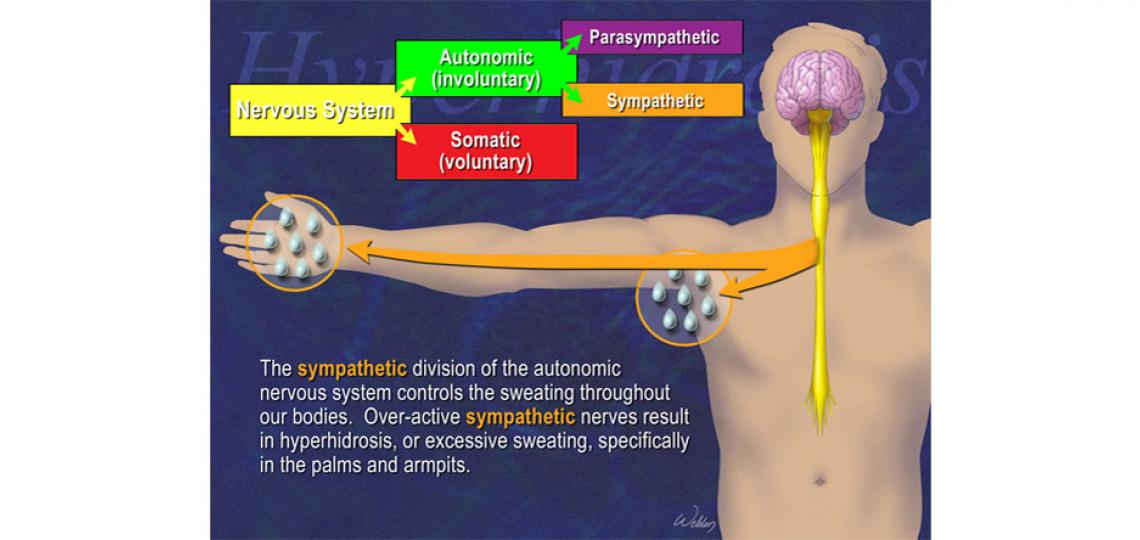Recognizing Excessive Sweating: Dermatology Insights on How to Stop Sweaty Hands
Recognizing Excessive Sweating: Dermatology Insights on How to Stop Sweaty Hands
Blog Article
Introducing the Complexities of Excessive Sweating: A Comprehensive Guide to Medical Diagnosis and Monitoring
Too much sweating, medically recognized as hyperhidrosis, is a condition that affects a significant number of individuals and can have a profound influence on their top quality of life. While sweating is a natural physical feature, its overactivity in hyperhidrosis presents an unique set of difficulties that usually go past mere discomfort.

Comprehending Hyperhidrosis Causes
Hyperhidrosis triggers can be attributed to different variables such as genes, hormone inequalities, and specific medical conditions. Genes play a significant role in main focal hyperhidrosis, where people acquire the condition from their family participants. By recognizing the certain variables adding to excessive sweating, healthcare suppliers can tailor therapy plans to attend to the underlying reason, offering alleviation and enhancing the top quality of life for people influenced by hyperhidrosis.
Identifying Hyperhidrosis Manifestations

Additionally, hyperhidrosis signs might manifest in social and emotional distress, as individuals may really feel embarrassed or distressed concerning their sweating, causing evasion of social situations (Treatment for hyperhydrosis of hands). Furthermore, duplicated episodes of extreme sweating can cause skin maceration, fungal infections, and a general decline in self-esteem
Diagnostic Process for Hyperhidrosis
Launching the analysis process for too much sweating involves thorough assessment of the person's case history and health examination. Making inquiries concerning the beginning, period, and triggers of sweating episodes is vital to distinguish between main focal hyperhidrosis and secondary generalised hyperhidrosis. Medical background should likewise consist of concerns concerning medications, clinical conditions, and family history of hyperhidrosis.
During the physical assessment, particular focus is paid to the locations impacted by sweating. The medical care carrier might evaluate the level of sweating, check for indications of underlying conditions, and assess the influence of sweating on the individual's lifestyle. In addition, specific tests like the gravimetric test, starch-iodine examination, or skin conductance dimensions might be conducted to measure the quantity of sweat generated.
Moreover, in situations where second hyperhidrosis is believed, additional examinations such as blood tests, pee examinations, and imaging studies may be recommended to determine the underlying reason for extreme sweating. The diagnostic procedure aims to precisely identify the kind and root cause of hyperhidrosis to guide suitable administration strategies.
Therapy Choices for Hyperhidrosis
When addressing excessive sweating, different treatment alternatives are readily available to ease signs and improve the individual's lifestyle. The treatment method for hyperhidrosis depends upon the intensity of signs and the client's action to preliminary therapies.
Topical therapies, such as aluminum-based antiperspirants, are usually suggested as the first line of defense for handling moderate situations of hyperhidrosis. For individuals with extra serious signs, dental medicines like anticholinergics may be prescribed to help lower sweating.
:max_bytes(150000):strip_icc()/sweaty-palms-palmar-hyperhidrosis-4691320-10512b2d428846059753b76df6dc74c2.png)
Effective Management Approaches
To successfully handle hyperhidrosis, a extensive and individualized therapy strategy customized to the client's particular demands and action to previous treatments is crucial. This strategy might incorporate a combination of restorative strategies, consisting of way of life modifications, topical therapies, dental medications, botulinum contaminant shots, iontophoresis, and in severe situations, medical interventions like sweat gland elimination or sympathectomy. Way of living adjustments such as using moisture-wicking clothing, making use of antiperspirants, and exercising stress-reducing strategies can complement medical treatments. Topical antiperspirants having aluminum chloride are usually the first-line treatment, with more powerful formulations offered for immune click to read cases. Dental medications like anticholinergics might be suggested for generalised hyperhidrosis. Botulinum toxin injections work for focal hyperhidrosis, providing temporary alleviation by obstructing the launch of acetylcholine. Iontophoresis, involving the usage of a reduced electrical existing to decrease gland task, can be advantageous for both palmoplantar and axillary hyperhidrosis. Surgical alternatives are usually reserved for extreme, refractory cases and need cautious consideration of risks and benefits. A multidisciplinary technique entailing skin doctors, main care doctors, and, if required, cosmetic surgeons, can enhance the administration of hyperhidrosis.
Verdict
In final thought, hyperhidrosis is a condition identified by too much sweating, which can greatly influence a person's high quality of life. With proper medical diagnosis and monitoring techniques, individuals enduring from hyperhidrosis can find alleviation and boost their total health.
Too much sweating, clinically understood as hyperhidrosis, is a condition that influences a considerable number of individuals and can have an extensive impact on their top quality of life. By determining the particular elements adding to excessive sweating, medical care service providers can tailor therapy strategies to address the underlying cause, supplying alleviation and enhancing the high quality of life for people impacted by hyperhidrosis.
Hyperhidrosis, identified by extreme sweating past site web what is needed for regulating body temperature level, can considerably influence an individual's quality of life. Asking regarding the onset, period, and triggers of sweating episodes is important to distinguish between key focal hyperhidrosis and click this link additional generalised hyperhidrosis. Exessive Sweating.In conclusion, hyperhidrosis is a condition characterized by too much sweating, which can considerably impact an individual's high quality of life
Report this page